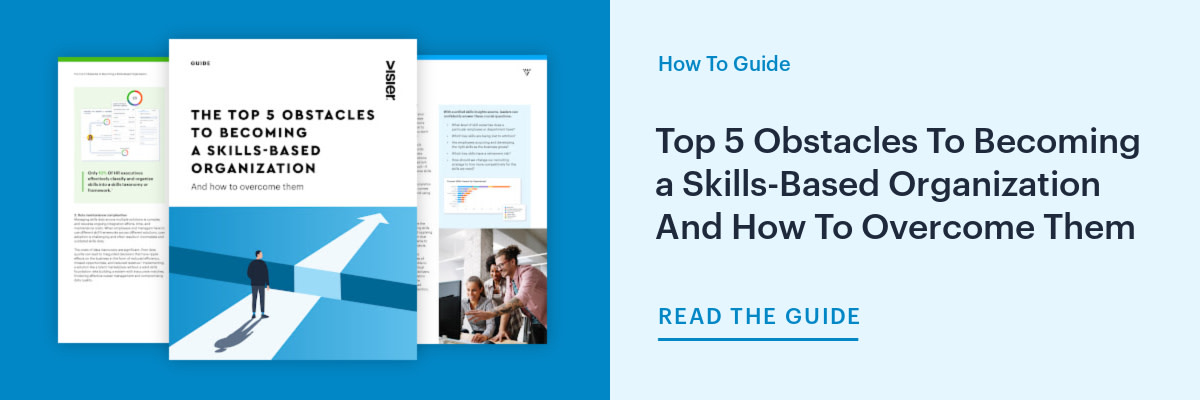In the AI Era, Workforce Planning Starts With Skills
Strategic workforce planning is critical for future-proofing organizations. In an era ripe with rapid technological disruption, starting with skills is essential. Learn more.

In the dynamic realm of business, the concept of strategic workforce planning (SWP) has emerged as a vital tool for future-proofing organizations. It's about anticipating future needs and crafting strategies for optimal workforce utilization. As we navigate through an era marked by rapid technological advancements and AI-driven disruptions, strategic workforce planning’s relevance becomes increasingly pronounced, serving as a compass for navigating the future of work.
At its core, strategic workforce planning is intertwined with skills. The shift from a traditional job-based approach to a skill-based model isn't just a trend—it's a response to the evolving business landscape. This transition is driven by the recognition that human capital, a key determinant of market value, predominantly consists of intangible assets. Remarkably, intangible assets represent approximately 90% of the total assets of the S&P 500, highlighting the critical importance of human skills in the current corporate equation.

Navigating strategic workforce planning in a technologically disrupted era
The acceleration era we find ourselves in moves us from linear progress to exponential disruption. This pace of change doesn't just affect the tech sector. It permeates every industry and business function. Organizations are increasingly aware that there isn't a single sector immune to the transformative impact of AI, automation, and technological advancements. These forces are reshaping jobs, which, in essence, are a collection of skills. The World Economic Forum's Future of Jobs Survey 2023 highlights a critical fact: 44% of worker skills will be disrupted by 2027, signaling a significant reshuffle in the job market with a projected 23% structural labor market churn
This reshuffle goes far beyond the general workforce; it's particularly pronounced in tech-related jobs. As McKinsey & Company's Technology Trends Outlook 2023 points out, the demand for tech skills far outstrips the supply, creating a talent gap that's becoming a critical battleground for competitive advantage. This gap represents the People Impact Gap, which, if left unaddressed, can become a corporate performance gap.
Strategic workforce planning requires a skills-based approach
Strategic workforce planning is inherently skills-based. This approach is not just about aligning skills with business needs. It's about agility, adaptability, and strategic foresight. A skills-based approach to strategic workforce planning offers a framework for organizations to quickly adapt to changes, mitigate talent shortages, and foster diversity and equity in the workplace.
However, the journey to a skills-based organization is fraught with obstacles. Despite the clear advantages, only a small percentage of organizations have successfully made the switch. The primary obstacles? Data management, skills taxonomies, and legacy mindsets. Collecting, standardizing, and maintaining a robust set of employee skills data is a Herculean task. It requires a solid foundation in data analytics and a hefty dose of AI. Moreover, shifting from a job-title-centric to a skills-centric view requires a significant mindset change across the organization.

Strategically crafting a skills-based workforce: From data to action
Moving forward, organizations need to chart a pragmatic, purpose-driven path in their skills journey. This means not pursuing skills development as an end in itself, but rather as a strategic tool for achieving business goals. Skills should serve as a unifying language that bridges various HR functions, from workforce planning to recruitment and beyond.
Building a strategic, skills-based workforce planning framework begins with establishing robust jobs and skills data. This process involves standardizing job roles for clarity, enriching this data with relevant skills, and assessing employee skill levels to understand and develop the existing skill set within an organization.
Strategic skill mapping follows, which includes analyzing potential skills loss due to factors like employee exits and retirement, and identifying skills at risk due to technological advancements. This mapping is crucial for future skills forecasting. The final step is transforming identified skill gaps into actionable strategies, aligning learning and development initiatives with these gaps, focusing recruitment on hard-to-find skills, and optimizing internal mobility. This comprehensive approach not only addresses current skill gaps but also equips the workforce for future challenges and changes.
Embracing the future with purpose and pragmatism
The journey toward successful skills-based workforce planning is a blend of clear intent, cohesive strategy, and practical execution. It revolves around leveraging advanced AI technologies to construct a robust skills infrastructure, which is essential in minimizing effort and maximizing impact.
This approach is not merely about meeting current demands but also about foreseeing and preparing for the future. As organizations take this path, they unlock unprecedented potential to transform their workforce, ensuring it is not only aligned with today's dynamic business landscape but is also agile and ready to embrace the uncharted possibilities of tomorrow.
This strategic foresight in workforce planning empowers businesses to navigate through evolving markets and technological disruptions, ensuring that they remain competitive and relevant in an ever-changing world.
On the Outsmart blog, we write about workforce-related topics like what makes a good manager, how to reduce employee turnover, and reskilling employees. We also report on trending topics like ESG and EU CSRD requirements and preparing for a recession, and advise on HR best practices like how to create a strategic compensation strategy, metrics every CHRO should track, and connecting people data to business data. But if you really want to know the bread and butter of Visier, read our post about the benefits of people analytics.



